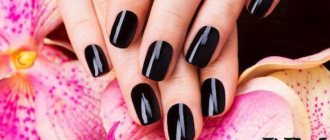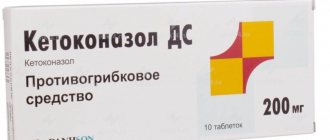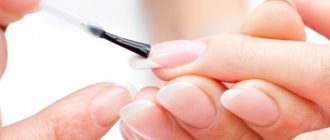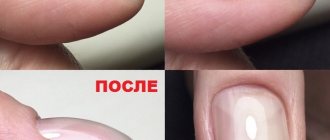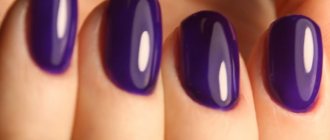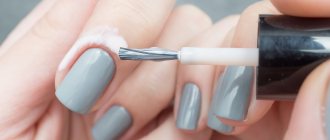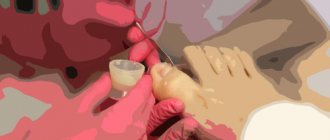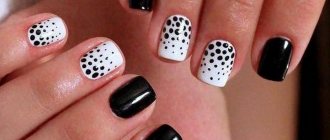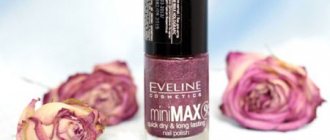The master should know this
Despite the fact that a master who practices a lot is considered good, the basis of any business is theory. It plays a huge role: there are many hidden points that a self-taught person may not know about, but which are basic.
The structure of the nail and nail plate for a manicurist is the very basis to which he should pay great attention to the study.
Structure
On three sides the nail plate is surrounded by skin ridges. The rollers on the sides are called lateral. The roller at the lower edge is called proximal (another name for eponychium), which means “located closer to the center,” since in reality the visible part of the plate is not the entire nail. The proximal roller has its own tasks and functions - it protects the root from the penetration of bacteria and foreign elements. The well-known cuticle is the dried part of the proximal ridge. There are people who develop pterygium - this is a phenomenon when the lower layer of the cuticle grows very actively, occupying almost half of the nail plate. It does not cause any harm, does not indicate any pathologies, but only violates the overall aesthetics.
The root is the lower part of the nail plate, protected by the proximal fold. However, still, part of the root looks out - it has a semicircular shape, has a lighter shade and is called “lunula” or simply “lune”.
In addition to the part that is under the skin layer, the nail has a free part. It starts from the “smile line” - a line that is a transition from that part of the nail plate that is connected to the skin and the free edge.
The upper part is called the hairline.
The nail plate has several layers:
- 1. The uppermost thin one, consisting of keratinized keratin, is called “Dorsal”. Has a protective function.
- 2. The middle layer is the thickest, consists of soft keratin and is called “intermediate”.
- 3. The last layer is called “ventral”.
Each of our fingers has a nail bed - a layer of connective tissue on which the nail plate is located, covered with a malpighian layer - a layer of the epidermis in which cell division constantly occurs due to this, the epidermis grows and regenerates. If you turn your finger with the inside facing you, you will be able to see a small part of the nail bed called the hyponychium on the back of the nail, at the base of the free edge.
At the bottom of the nail bed, under the root, there is a matrix - the place where the nail plate originates. The matrix consists of epithelial cells, in the middle layer of which there are onychoblast cells - they form the nail plates.
Cuticle on the nail - anatomy
From the ridges around the body of the nail, a thin protective film, called the cuticle, seems to grow onto the horny plate itself.
IMPORTANT: The cuticle consists of two types of cells - living and dead. Living cells are located closer to the skin folds, dead cells are located closer to the keratin plate. The dead part of the cuticle is easily damaged and develops hangnails, which quite often leads to inflammation of the living areas of the skin around the nail
The main function of the cuticle is protective. The film is needed to prevent bacteria, dust, and other foreign bodies from getting into the cracks between the nail and the skin. Onychologists and manicurists are still debating whether it is necessary to remove the cuticle.
Previously, it was believed that a beautiful manicure with this film was simply impossible, and it was mercilessly cut off with scissors or bitten off with tweezers. Today, the majority is inclined to believe that the living part of the cuticle is needed. After softening with special means, the dead material is removed using a router attachment or carefully pushed away with a stick. It is also recommended to care for the cuticle using:
- baths
- massage
- special oils and creams
What are human nails made of?
They are mainly composed of keratin, a protein considered one of the strongest biological materials. But numerous sulfur atoms help it form a solid form.
However, it cannot be said that human nails are as hard as animal claws, since we have fat and water between the layers. They give the nail plate flexibility and shine. However, too much water is also bad. The nail is able to absorb it and then it becomes too soft and may begin to peel.
But vitamins are good, because in addition to everything else, nails contain the sulfur-containing amino acid cystine and chemical elements: calcium, zinc, selenium, chromium, phosphorus.
Nail plate.
The nail plate (nail), in turn, consists of many transparent keratinized plates, folded like tiles. Thanks to this structure, the nail plates have a porous structure. They actively absorb and release (sweat) moisture, 100 times more intense than human skin. Exudation through the nails accounts for 12-15% of the exudation of the entire surface of the body. The high permeability of the nail plates allows the effective use of medicinal varnishes and creams to affect the tissues under the nail. Due to this permeability, in people whose hands are often in contact with water, the nail plates become noticeably thicker over time.
How quickly do fingernails and toenails grow?
Their birth occurs in the womb. They begin to develop at about 12 weeks and growth does not stop anymore. The baby's nail reaches the end of the finger just at the moment of birth.
However, some circumstances can negatively affect their growth:
- • Mechanical factor. This includes the disgusting habit of biting nails, as well as work that injures, breaks them, mechanical grinding due to a large amount of time spent typing on the keyboard, etc.
- • Hormonal factor. Hormonal changes in the body are most often associated with pregnancy, lactation, adolescence, change of seasons, and health problems.
- • Poor nutrition. Food is fuel for the body. The normal operation of all its parts depends on its quality. Food low in vitamins, fast food, alcohol, tobacco, and other unhealthy things have a very negative effect on growth.
Surprisingly, the nail plates on the feet and hands grow at different rates: on the hands - 1-2 mm per week, on the feet - no more than 1 mm per week.
Interesting facts about nail growth:
- – in men they grow more slowly;
- – on the right hand (if you are right-handed) they grow faster;
- – in the warm season, growth accelerates;
- – grow better in the light than in the dark;
- – completely updated twice a year.
Nail shape and length
The shape of her nails and their length can tell a lot about a girl’s character. Moreover, the one that the girl wears all the time.
Long nails indicate a woman’s bitchy character, her playfulness and capriciousness, and sometimes laziness and the desire to get more from life at the expense of other people’s efforts and efforts.
Such girls love society, glamor and luxury.
Short nails do not always indicate character, especially if the girl works as a nurse, piano teacher or pastry chef.
There, short and neat nails are one of the job requirements.
But if the girl is not a musician or a pastry chef, then short nails indicate that the girl is purposeful, neat and complex, to a greater or lesser extent.
As soon as her femininity is revealed, they will become longer.
Medium-length nails are typical for most women and can tell little about their character.
The shape of nails can tell a lot about the character of a modern girl.
The square shape reveals a purposeful nature. Such women are practical, smart and independent; they claim leadership in the family and can be despotic.
Long, square-shaped nails can indicate suppression of others and a desire to command.
The elongated oval shape reveals a soft feminine nature.
It is easier for her to bypass obstacles than to go ahead. Most often, she is a good lover and a wise wife, which most men like.
Long oval-shaped nails hint at a calm nature in which passion gradually matures.
Usually these are vulnerable people who love to play the role of a flirtatious cat with soft fluffy paws.
Long pointed nails indicate a lady with pretensions.
Usually this is a passionate, capricious and slightly eccentric person, whose mood changes a hundred times a day, and who is not easy to please and please.
Such ladies are often called bitches.
Well, medium-length and square-shaped nails may indicate a musical and vulnerable nature, which has not yet had time to part with romantic dreams.
What a healthy nail should look like
- • Color: uniform pale pink.
- • Surface: shiny, smooth.
- • Lunula: clearly defined, white in color.
- • Cuticle: moisturized, no burrs.
- • Shape: depends on individual characteristics, but it must be even!
- • Growth: constant, uniform.
- • Thickness: medium. However, depending on age, it may change. So, in children, thin nails are considered normal, while in older people, thick nails.
- • Nail plate: elastic, dense, not susceptible to slight damage.
- • Free edge: smooth, white.
Of course, each person has their own characteristics of nails: features of structure, shape, strength. This may well be inherited, but if unusual changes begin to occur, this is a reason to worry.
Matrix (nail root).
The matrix is exactly the place where the nail is formed, and on which all its parameters depend: shape, thickness, density and growth rate. The structure and shape of the matrix are individual and depend on the genetics of the person. If the nails are naturally thin, then the matrix is short, and this cannot be changed, but you can use products to artificially strengthen the nails: varnishes, gels, acrylics. If the nail plate begins to thin out over time, under the influence of a painful condition, dystrophy or injury, it is possible to find out the cause and restore the size of the matrix.
Severe damage to the matrix can lead to deformation of the nail or complete cessation of its growth.
How to keep your nails healthy
- 1. Proper balanced nutrition. If it is not possible to consume foods rich in microelements in adequate quantities, be sure to take vitamins!
- 2. Nourishing cream, cuticle oil. Women are nowhere without these products: constant contact with water greatly dries out the skin and cuticles.
- 3. Use of household gloves. A great way to reduce the harmful effects of household products and water on your hands.
- 4. Comfortable shoes. Millions of women know that problems with toenails most often occur after wearing tight but beautiful shoes for a long time. For wide feet, it is worth choosing appropriate shoes, rather than hoping that they will wear out.
- 5. In the pharmacy, you can find special varnishes: strengthening, protective, restoring.
- 6. Having reached a certain length, the plate begins to break, do not allow this to happen, file the edge in time - a short nail plate is less susceptible to brittleness.
- 7. Baths. Baths with salt or oils can breathe life into tired nails.
- 8. Professional care. Of course, this is not a mandatory, rather expensive item. However, by having it professionally treated just a couple of times a year, you will notice that daily maintenance has become much easier.
Society and culture[edit]
Fashion[edit]
Main articles: manicure and pedicure
Toenails painted purple
Manicure (hands) and pedicure (feet) are health and beauty treatments for nail care, cutting and painting nails, and treating calluses. They require various tools such as cuticle scissors, nail scissors, nail clippers and nail files. Artificial nails can also be attached to real nails for cosmetic purposes.
A person involved in cutting, shaping and caring for nails, and applying topcoats such as acrylics and UV gels is sometimes called a nail technician. The place where a nail technician works may be a nail salon, a nail shop, or a nail bar.
Manicure
Painting your nails with colored nail polish (also called nail polish and nail polish) to enhance their appearance is a common practice dating back to at least 3000 BC. With the advent of smartphones, some analysts have noted a trend towards selfies
(selfie on
nails
). , where people share their nails online. [26]
Length entries[edit]
Guinness Book of Records
began tracking record nail lengths in 1955, when a Chinese priest's nails were recorded to be 1 foot 10.75 inches (57.79 cm) long.
Current male record holder, according to Guinness
, - Sridhar Chillal from India, who set the record in 1998 with a total of 20 feet 2.25 inches (615.32 cm) of nails on his left hand. His longest thumbnail was 4 feet 9.6 inches (146.3 cm) long.
The female record holder is Lee Redmond from the US, who set the record in 2001 and as of 2008 had nails totaling 28 feet (850 cm) in length on both hands, with the longest nail on her right thumb at 2 feet 11 inches. (89 cm). [27]
What the changes will tell you: description and photo
Surprisingly, our nails are able to tell us about the changes that occur deep in our body.
- • Longitudinal stripes – lack of vitamins, disruption of the gastrointestinal tract;
- • Transverse stripes - the cause of occurrence is a strict diet, or mechanical damage to the matrix (including manicure instruments);
- • Concave nail plate – indicate problems with the endocrine system;
- • White spots - they appear due to the formation of air between the layers of the nail plate. Depending on the intensity, they indicate a lack of zinc, nervous tension, heart failure;
- • The effect of watch glasses is a sign of serious diseases of the heart, lungs, blood vessels, and gastrointestinal tract.
- • Severe, unfounded fragility is a sign of a serious vitamin deficiency that needs to be replenished.
- • Change in color of the nail plate
- – blue – indicates poor blood supply to both the nails and, possibly, the whole body. You shouldn’t joke about this, as oxygen deficiency can also manifest itself, which is very dangerous to health;
- – yellowness – speaks of intoxication of the body, that is, a failure of the organs that cleanse our body: kidneys, gall bladder, liver, sometimes lungs;
- – with a green tint – indicate purulent inflammation;
- – white – this is the first sign of liver cirrhosis. If the whitishness is not very pronounced, it may be a sign of a disease of the gastrointestinal tract and heart. If only half of the nail plate is white, pay attention to the condition of the kidneys.
- – purple color – indicates that the body is overloaded and is working with all its might. The main reason for this condition is blood stagnation associated with heavy foods that predominate in the diet.
- – general pallor – indicates anemia or problems with the spleen.
- • Indentations in the form of small dots are a sign of psoriasis or eczema. May sometimes indicate arthritis;
- • Lack of lunula – lack of B vitamins and anemia;
- • Large lunulae – problems with the heart, blood vessels and blood pressure;
- • Exfoliating – notify about an unbalanced diet and lack of vitamins;
- • The nail plate moves away from the nail bed. This usually occurs due to mechanical damage, however, the cause can also be: allergies, fungus, various dermatological diseases, diseases of the nervous system and others. In this case, it is better to consult a doctor, because the symptom is associated with a huge number of disorders.
- • Black stripes – if the nail has not been injured (and you are unlikely to forget this), you need to pay attention to the health of the gastrointestinal tract.
- • Hangnails – lack of vitamins.
An uneven nail plate and other deviations from the norm can be symptoms of a variety of diseases, so be sure to consult a doctor.
Nail sinuses (sinuses).
Nail sinuses are depressions at the transition points from the nail fold to the nail plate. The nail sinuses are protected from the penetration of bacteria and dirt by the cuticle, although this protection is not always enough, therefore, when performing a manicure, the sinuses are carefully processed with a manicure instrument to remove ptegirium and other deposits. Treatment of the nail sinuses is very important for maintaining the healthy condition of the entire nail apparatus and, especially, for preparing for subsequent coating with varnishes, gels and acrylics, preventing peeling of the artificial coating.
Theory of connection between fingers and internal organs: diagram
Our body is a single system and everything in it is interconnected. Some believe that fingers and toes are connected to our internal organs and reflect their condition. Massage therapists and some other specialists use this knowledge in their work.
If you notice any changes on your nails, knowing which finger belongs to which organ, you will be able to determine in which organ a malfunction may have occurred.
- Little finger – Heart
- Unnamed – Kidneys
- Middle – Intestines
- Index – Lungs
- Big – Brain
Remember, no video lessons will teach a manicurist the correct tactics of behavior when a client has problem nails. Moreover, if you come for a medical manicure, pay attention to the specialist’s diplomas - these are some of the most important documents that give him the legal and moral right to carry out his activities!
Be healthy and beautiful!
Author Evgenia Lizarenko especially for the website Style40plus.ru

